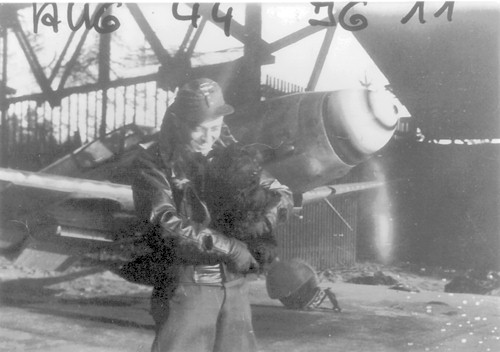August 1944 : Lt. Richard Franz with his dog in front of his ME 109 G14/AS “GREEN 1” as Sqdn. Cmdr. with 7./JG
11. This is the A/C in the dogfight with Maj. Hiro. The picture also shows his mechanic sitting in the cabin for a run up.
“…the other side – Air combat over Arnhem between II./JG11 and 357th FG on Sept 19th, 1944”
Fifty eight years after this air battle, 1st Lt Richard Franz describes his recollections of this day “on the other end” of the description in “The Yoxford Boys and the Arnhem Affair: The 357th FG in operations during the air battle on 19 September 1944”. 1st Lt Franz was at this time the Captain of 7th Squadron of II. Group, in the 11th Fighter Wing (7./JG11). He was an experienced fighter pilot with 6 shoot downs (1 x P47 and 5 x B17), which he achieved as pilot in STURMSTAFFEL 1 and in 11./JG3 between Dec 43 and May 44. Lt Franz was shot down over Berlin in aerial combat on Apr 25th 1945, while Captain of 1./JG11, and ended WWII as a POW in Russia with a total of 23 certified shoot downs. He himself had been shot down 6 times; he baled out one time and made 5 belly landings. After returning from Russian POW camps on Dec 23rd 1947, he joined the newly created German Air Force on Jan 1st 1956. He was than acting as flight instructor on Harvard AT-6 and Fouga-Magister CM 170 to train young German fighter pilots in Landsberg/Lech, Bavaria, Germany. He retired in 1980 as Lt. Colonel at the age of 58 (born on Oct 10th 1922).
“We (II./JG11) started on Sep 19th 1944 at 1700 hours local time from Breitscheid operations field with 19 aircrafts (Me 109 G-14/AS) for the 2nd sortie of this day, heading northwest in direction Arnhem. These Me 109 G-14/AS were special high altitude fighters with methanol injection and tall wooden rudder, armed with two 13-millimeter MG131 machine guns (on top of the engine) and a 20 mm MG 151/20 cannon (firing through the spinner). Our task for this mission was fighter sweep in the area of Arnhem and/or attacks on allied ground targets. II./JG11 consisted of the 7th Squadron (7./JG11) and 8th Squadron (8./JG11), each divided into 2-3 flights.
We reached the area above Arnhem at approximately 1740 hours, up to then without enemy contact. The whole unit was led by Lt. Wolf, Captain of 8./JG11. The Me 109s of 8./JG11 were at 7000 ft, while I was leading 7./JG11 as high cover at 9,000 ft. The weather situation was 9/10 at 14,000 ft with strongly restricted visibility down to the ground due to haze.
At approximately 1750 hours Lt Wolf sighted a single P-38 at low altitude, apparently performing reconnaissance, and descended on it. All aircrafts of his 8th Squadron followed him in this dive, unfortunately they did not react to my warning over the radio to stay at 7,000 ft. The result was as follows: 7th Squadron (7./JG11) as altitude cover at 9,000 ft, the rest of the group (8th Squadron) at approximately 3,000 ft.
At the same time, a far superior unit of P-51s (surely more than 40-50 aircrafts) started their attack from approximately 13,000 feet, partially coming out of cloud cover. As far as I know now, those were aircrafts of the 357th FG (362nd FS and 363rd FS). Immediately I climbed with my squadron steeply upward to engage the attacking P-51s. Among others, there was myself in “Green 1”, my wingman Warrant officer Roesner in “Green 3”, Ssgt Schinnerling in “Green 11” and Sgt Loefler in “Green 15”, all of us flying Me 109 G-14/AS.
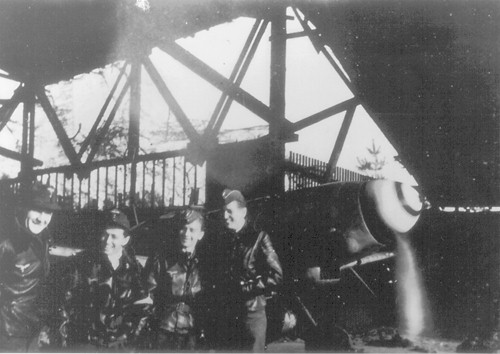
October 1944 : Lt. Richard Franz in front of his new A/C “YELLOW 1” (which he got after loosing “GREEN 1″on Sept 19th 1944) with the A-flight of 7. / JG11. From left to right: Sgt. Harald Schwarz (YELLOW 4 / KIA Jan 1st 1945), First Lt. Richard Franz (YELLOW 1 / POW April 25th 1945 in Russia), Warr.Officer Erhard Roesner (YELLOW 2 / he flew as Lt. Franz’s wingman on Sept 19th and was shot down the same dogfight. MIA May 3rd 1945), Lt. Rudolf Holdermann (YELLOW 3 / KIA May 1st 1945)
The aerial combat developed into a wild dog fight between the P-51s and our Me 109s at the closest quarters and at varying altitudes between 12.000 ft and the deck. It was impossible to maneuver into a firing position without been attacked at once. I attempted a dozen or more times to position myself behind a P-51, but had to break off in seconds as other P-51s turned in on me to attack. During this dogfight my wingman Roesner lost contact to me (he had reported to the squadron around August 1944 and this was his 1st or 2nd enemy contact flying with 7../JG11. Roesner is MIA after aerial combat on May 3rd 1945 in the east).
During this engagement, I saw a P-51 below me, which was behind a Me109, and had already damaged it heavily. Both aircraft were in a flat descent, I positioned myself with a half down turn approximately 300 yards behind the P-51, opened fire at 200 yards with machine gun and cannon, and closed in to 100-150 yards. At the same moment, the Me109 disintegrated as the P-51 was firing on it. I placed heavy hits on motor and cabin of the P-51 and observed parts flying off and black smoke. The aircraft continued a flat descent and crashed at approximately 1755hrs in the vicinity of Vreden. All together I stayed for 10-20 seconds behind the P-51, and then broke off to the right.
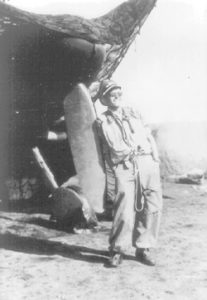
1st Lt Richard Franz
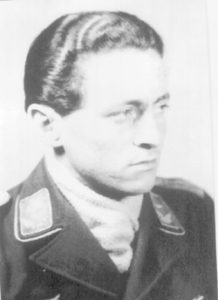
At the same moment I received severe hits on engine and right wing. My engine started to smoke at once and lost almost all power. I pushed down and looked for emergency landing possibilities. A crash landing followed on flat land, where the aircraft continued at high speed into a forest loosing both wings. I was recovered from the aircraft lightly injured and was taken care of by soldiers of the 10th SS Panzer Division, a tank unit. The emergency landing occurred in the vicinity of Zwolle, approximately 6 km west of Vreden.
After medical treatment I was taken in a staff car to the position HQ in Enschede, where I met my wingman Roesner who was not injured. He had been shot down and was able to parachute to safety. During the same sortie, Ssgt Schinnerling and Sgt Loeffeler (both experienced pilots) were also shot down, and both were injured in their subsequent crash landings.
II./JG11 lost a total of 8 aircrafts and achieved 6 shoot downs during the mission.
Research by my friend Klaus Hastreiter and me determined that the pilot I shot down was Maj Edwin W. Hiro from the 357th FG/ 363rd FS, flying a P-51D named “Horse’s Itch.” Ted Conlin (357th FG/362nd FS) wrote to inform us that he had witnessed the shoot down. He saw the Me109 with Ed Hiro’s P-51 behind it, with my Me 109 pursuing in a flat descent. Ted Conlin rolled behind my Me109 and closed in to help Ed Hiro, but had to break off when he was attacked by Lt Wroblewski, who had shot down Ted Conlin’s wingman Blanchard before. Click here to read Ted Conlin’s account.
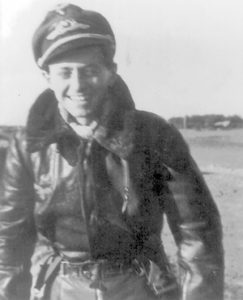
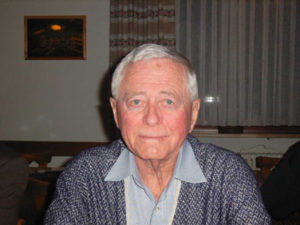
We would like to express our appreciation and thanks to Richard Franz for allowing us to tell his story and to Klaus Hastreiter for working so hard to make this possible. Thanks also to Peter Krueger and Erik Whipple for helping to translate the story into English. A sincere thank you to Ted Conlin for providing details to the story. Read Merle Olmsted’s account of 357th FG involvement in the combat at Arnhem.
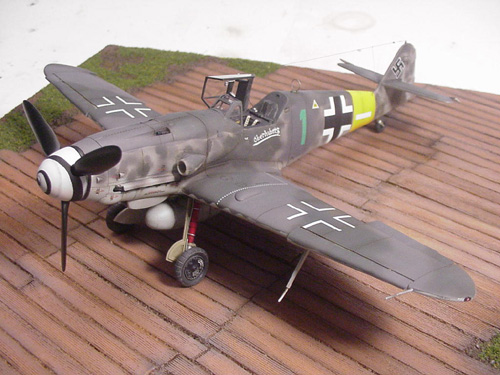
Model of Richard’s ME109G-14/AS “Green 1” built by Erik Whipple. Click here for more details of this beautiful model.
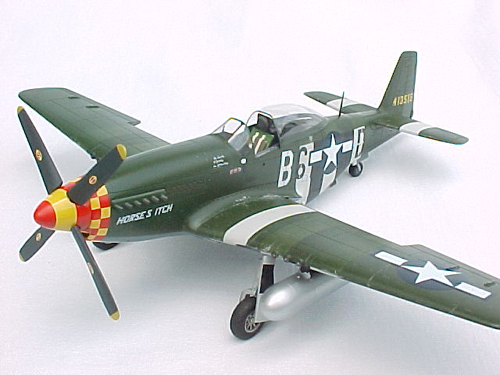
Model of Ed Hiro’s P-51D “Horse’s Itch” built by John Soule. Click here for more details on this beautiful model.
Richard’s story is presented here in German:
58 Jahre nach dieser Luftschlacht schildert OLt. Richard Franz seine Erinnerungen an diesen Tag quasi “…am anderen Ende” des von Merle Olmsted in ” THE YOXFORD BOYS AND THE ARNHEM AFFAIR : THE 357th FG IN OPERATION” beschriebenen Luftkampfes am 19.09.1944. OLt. Franz war zu diesem Zeitpunkt Staffelkapitän der 7.Staffel der II.Gruppe im Jagdgeschwader 11 (7./ JG 11). Er war erfahrener Jagdflieger mit 6 Abschüssen (1 x P-47 und 5 x B-17), die er als Pilot der STURMSTAFFEL 1 und in der 11./ JG 3 von Dezember 1943 – Mai 1944 erzielte. Lt. Franz wurde am 25.04.1945 über Berlin als Staffelkapitän der 1./ JG 11 im Luftkampf mit JAK-9 abgeschossen und beendete den 2. Weltkrieg mit insgesamt 23 bestätigten Abschüssen als POW in russischer Kriegsgefangenschaft. Er wurde 6 mal abgeschossen, sprang dabei 1 mal mit dem Fallschirm ab und mußte 5 mal notlanden. Nach Rückkehr aus der russischen Kriegsgefangenschaft am 23.12.1947 trat OLt. Franz am 1.Januar 1956 in die neu gegründete deutsche Luftwaffe ein und war als Fluglehrer auf AT-6 und Fouga-Magister CM 170 in der Ausbildung für junge Jagdflugzeugführer in Landsberg/Lech (Deutschland) tätig. Er ging 1980 als Oberstleutnant mit 58 Jahren ( geb. 10.10.1922 ) in den Ruhestand.
“Am 19.September 1944 starteten wir (II./ JG 11) um 17:00 Uhr Ortszeit vom Einsatzplatz Breitscheid mit 19 Maschinen Me 109 G-14/AS zum 2. Einsatz an diesem Tag nordwestlich in Richtung Arnheim. Bei den Me 109 G-14/AS handelte es sich um spezielle Höhenjäger mit Methanoleinspritzung, teilweise Holzleitwerk und 2 x 13 mm MG (MG 131) im Cowling und eine durch die Nabe feuernde 20 mm-Kanone (MG 151/20). Unser Auftrag für diesen Einsatz lautete: Freie Jagd im Raum Arnheim und/oder Bekämpfung von Bodenzielen der Alliierten Luftlandeeinheiten. Die II.Gruppe JG11 (II./JG 11) bestand aus der 7.Staffel JG 11 (7./JG 11) und 8.Staffel JG 11 (8./JG 11), je Staffel aufgeteilt in 2 – 3 Schwärme.
Wir erreichten mit dem Verband um ca. 17:40 Uhr den Raum über Arnheim, bis dahin ohne Feindberührung. Der Gesamtverband wurde von Lt. Wolf (Staffelkapitän 8./JG 11) geführt. Die Me 109 der 8./ JG 11 in 7.000 ft, die Maschinen des Höhenschutzes (7./ JG 11) in 9.000 ft. Die 7./JG 11 wurde durch mich (OLt. Franz) geführt. Die Wetterlage war ca. 10/10 in 14.000 ft. mit stark eingeschränkter Sicht durch Dunst bis zum Boden.
Um ca. 17:50 sichtete Lt. Wolf (Staffelkapitän 8. / JG 11) eine tiefer fliegende P-38 (anscheinend Fotoaufklärer) und drückte mit der gesamten Staffel von 7.000 ft auf sie runter und schoß sie in ca. 3.000 ft. ab. Meine Warnung über FT, keine Höhe aufzugeben, war vergeblich. Hierdurch war die Ausgangssituation wie folgt : Höhendeckung in ca. 9.000 ft., Rest der Gruppe in ca. 3.000 ft.
Im gleichen Moment erfolgte aus überhöhter Position ( ca. 13.000 ft) der Angriff eines weit überlegenen Verbandes von P-51, sicherlich mehr als 40 – 50 Maschinen. Nach meinen Recherchen waren es vermutlich Maschinen der 357th FG ( 362nd FS + 363rd FS).
Ich zog sofort mit meiner Staffel aus ca. 9.000 ft. den stürzenden P-51 steil nach oben entgegen und nahm den Luftkampf auf. Es waren dies unter anderem : Meine “grüne 1“, mein Wingman Ofhr. Rösner (grüne „3“), Feldwebel Schinnerling (grüne „11“) und Uffz. Löffeler (grüne “15”), alles Me 109 G-14/AS.
Der Luftkampf entwickelte sich zu einer wilden Kurbelei von P-51 und Me 109 auf engstem Raum und in wechselnden Höhen zwischen 12.000 ft. und Bodennähe, wobei es unmöglich war, sich in Schußposition zu manövrieren ohne selbst beschossen zu werden. Ich versuchte ca. 10 – 15 mal, hinter eine der P-51 in Schußposition zu gelangen, mußte aber jeweils schon nach Sekunden wegbrechen, da andere P-51 auf mich eindrehten und ich selbst angegriffen wurde. Während dieser Kurbelei platze mein Wingman Ofhr. Rösner ab (er kam erst ca. August 44 zu unserer Staffel, es war bei uns sein 1. oder 2. Feindflug. Ofhr. Rösner gilt nach Luftkampf am 03.05.1945 als vermißt).
Im Verlauf dieses Luftkampfes sah ich unter mir eine P-51, die ihrerseits hinter einer Me 109 saß und diese bereits durch Beschuß schwer beschädigt hatte. Beide Maschinen befanden sich in flachem Sturz. Ich setze mich mit halben Abschwung in ca. 300 yards hinter die P-51 und eröffnete ab 200 yards das Feuer mit MG und Kanone und näherte mich dabei auf ca. auf 100 – 150 yards. Im selben Moment zerlegte auch die Me 109 unter dem Feuer der P-51 vor mir. Ich erzielte schwere Treffer in Motor und Kabine der P-51 und sah, wie Teile wegflogen und die Maschine mit schwarzem Rauch zeichnete. Die P-51 blieb im flachen Sturz und schlug ca. 17:55 Uhr in der Nähe der Ortschaft VREDEN auf dem Boden auf. Insgesamt blieb ich ca. 10 – 20 Sekunden hinter der P-51 und brach dann nach rechts weg.
Im Wegbrechen wurde ich im Motor und der rechten Fläche getroffen, diesen Gegner habe ich nicht gesehen. Der Motor meiner Me 109 hat sofort stark gequalmt und verlor fast die komplette Leistung. Ich habe sofort nach unten gedruckt und nach einer Notlandemöglichkeit gesucht. In dem dortigen Flachland erfolgte die Bauchlandung, die Maschine rutschte mit hoher Geschwindigkeit in einen angrenzenden Wald und verlor hierbei beide Flächen. Ich wurde von Soldaten einer dort im Ruheraum liegenden Panzereinheit (10.SS-Pz.-Division) aus der Maschine leicht verletzt geborgen und versorgt. Die Notlandung erfolgte in der Nähe der Ortschaft ZWILLBROCK (ca. 6 km westlich von VREDEN).
Mit einem Stabswagen wurde ich nach ärztlicher Versorgung zur Standortkommandatur Enschede gefahren, wo ich meinen Wingman Ofhr. Rösner unverletzt traf. Er wurde im Luftkampf abgeschossen und konnte sich am Fallschrim retten. Beim gleichen Einsatz wurden auch Fw. Schinnerling und Uffz. Löffeler ebenfalls abgeschossen, beide wurden bei der Bauchlandung verwundet. Bei beiden Piloten hatte es sich um erfahrene Flugzeugführer gehandelt.
Insgesamt verlor die II./JG 11 in diesem Luftkampf 8 Flugzeuge und konnte demgegenüber 6 Abschüsse erzielen.
Recherchen meines Freundes Klaus Hastreiter und mir ergaben, daß der von mir abgeschossene Pilot vermutlich Maj. Edwin W. Hiro von der 357th FG / 363rd FS, A/C “Horses Itch” war. Ted Conlin (357th FG / 362 FS) schrieb uns, daß er die Abschußsituation beobachtet hatte. Er sah die Me 109, dahiner die P-51 von Mj. Hiro, dahinter die Me 109 von Olt. Franz im flachen Sturz. Ted Conlin rollte hinter Olt. Franz und schloß auf zur Hilfe, mußte aber wegbrechen, da er durch Lt. Wroblewski angegriffen wurde (der kurz vorher Ted Conlin’s wingman Blanchard abgeschossen hatte). Ted Conlin schrieb an uns am 23.01.2002 : “I was not able to shoot at his (Lt. Franz) aircraft due to Lt. Wroblewski who shot down my wingman, just prior to my closing with Major Hiro, his target 109 an Lt. Franz behind him. When I saw the cannon fire over my left wing, I broke right and climbed to 10.000 feet to Lufbery with my attacker. No one came up so I dove back down to 2.000 ft where I saw 9 burning wrecks scattered over about a 30 miles area. This tallies with the loss and victory reports filed later.”

